Digital Age of Medicine
- System-based approach to delivering of precision medicine.
- Evidence-based treatment delivery and efficient healthcare solutions.
- New comprehension of illnesses through technology assistance.
- Transformed approach to treatment via software tools.
- More effective decisions and accurate treatment planning.
- Next generation healthcare, making patients stay involved.
- Improved diagnostics and more precise treatment algorithms.
Precision medicine – is a model of medicine, concentrating medical practices on an individual patient.
Evidence-based treatment delivery – data exchange system, where relevant information is accessible to both clinicians and patients.
Transformed approach to treatment – adaptation to the new care models with the help of technological means, such as wireless fitness trackers and medication adherence tools.
Next generation healthcare – patients are fully engaged in their care, being able to access data remotely.
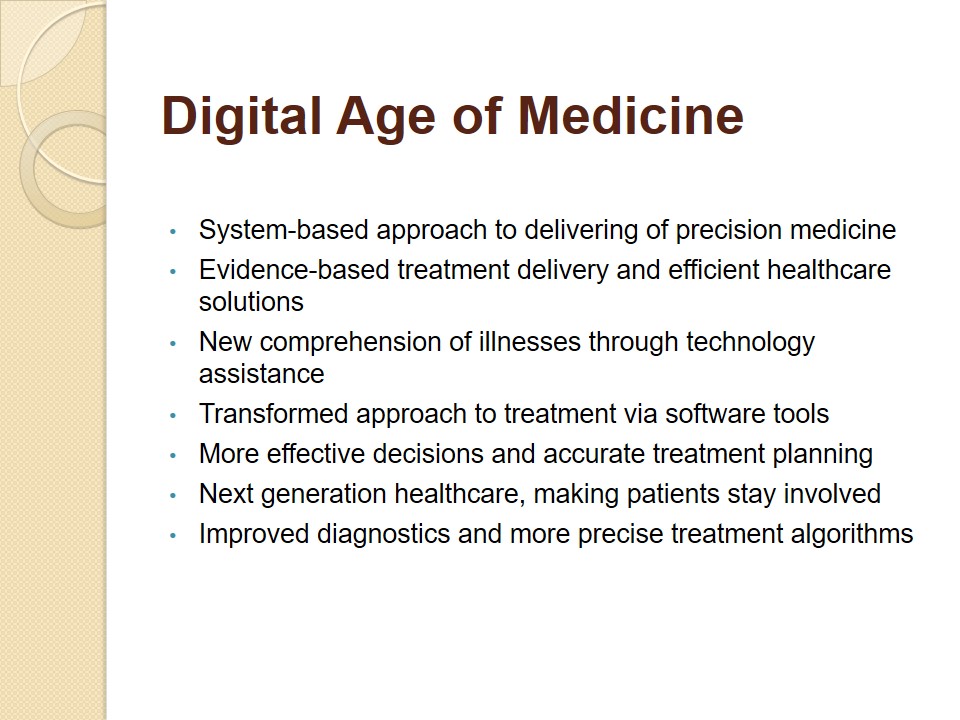
The Major Technology Innovations
- NantOS – NantHealth’s cloud-based operating system (Lapton, 214).
- Provider Portal – portal with a continuum-wide access.
- Health Notebook – makes patients equal care participants.
NantOS – NantHealth’s cloud-based operating system. It offers not only “access to medical and health information on the Internet but also new ways of monitoring, measuring and visualizing the human body and sharing personal information and experiences with others” (Lapton, 2014, p. 175).
Provider Portal – collection of patients’ clinical data that are available for providers’ access across the care continuum. Since it represents a full community picture, a viewer always receives a whole set of data. Thus, it allows physicians to have a longitudinal view of a patient’s record.
Health Notebook – one more database, connecting patients with their providers and allowing them to participate in care.
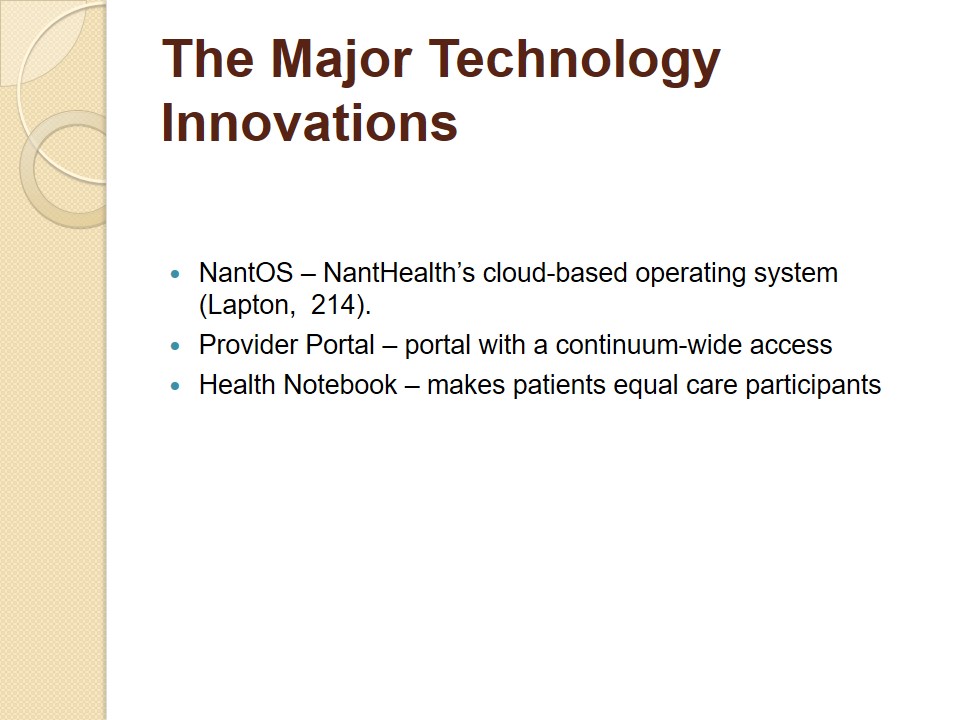
NantOS-based Provider Portal
- Represents a unified collection of patients’ data.
- Offers providers a comprehensive view of cases.
- Provides quick cloud-based data access (Topol, 2013).
- Gives exhaustive information on care improvement.
- Grants data customization for specific disease states.
- Allows for organized access to the records.
- Assists clinicians in making the right decisions.
Providers across the care continuum gain access to the same sources of data, thus, receiving all the necessary information and sharing it in a blink of an eye. This “unlimited computing power via cloud server farms” opens new horizons in the matters of healthcare and overall treatment efficiency (Topol, 2013, p. 7). Clinicians acquire access to the records in an organized manner, which can seriously assist them in the matters of decision-making.
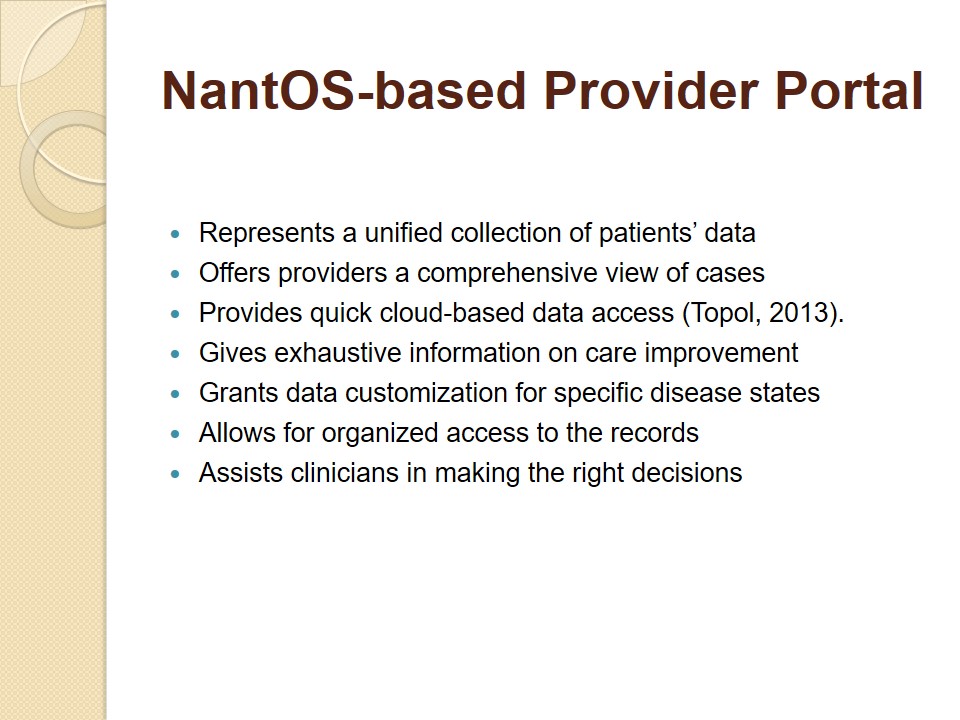
NantOS-based Health Notebook
- Connects patients with providers, insurers, and records.
- Serves as motivation to participate in care.
- Reduces providers’ operational costs; improves data transferring.
- Expands care delivery (Caulfield and Donnelly, 2013).
- Establishes connection with remote and wireless devices.
- Assists with decision-making through cooperation with patients.
- Forms backgrounds for advanced precision medicine introduction.
Health Notebook was primarily introduced to provide an easier data exchange between clinicians and patients and create motivational concepts for the latter to reach their goals. The database seriously contributes to the providers’ operational costs reduction and expanding a “technology enabled model of healthcare delivery” (Caulfield and Donnelly, 2013, p. 703). The fact it can be accessed remotely through any device forms a background for further implementation of precision medicine models.
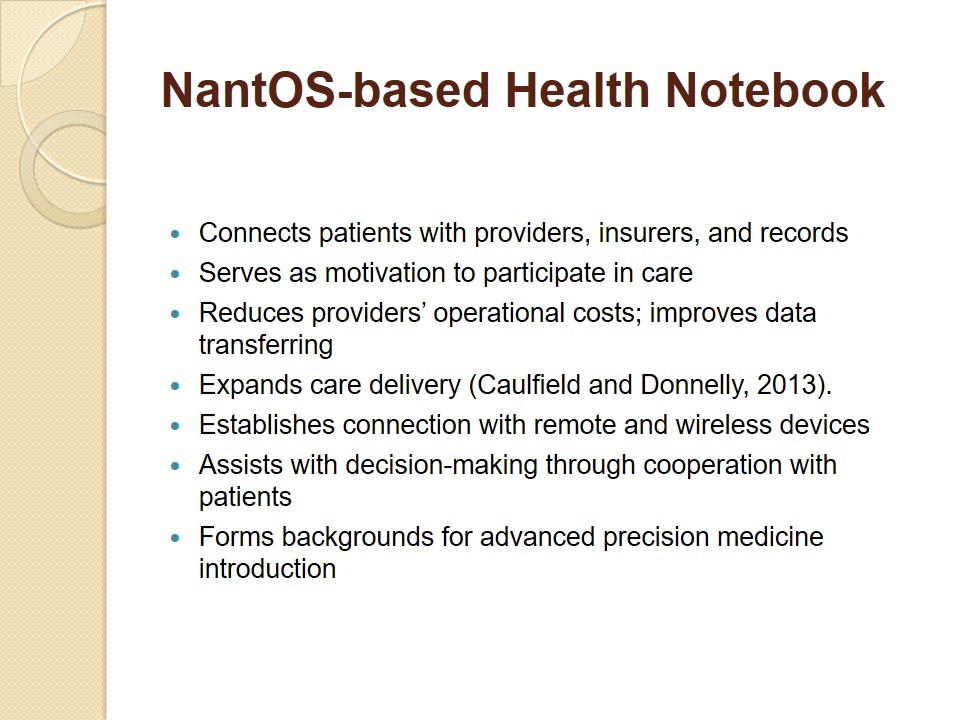
Premises for outcome-focused planning
- Technology improves clinical, operational and financial outcomes.
- Same number of staff manages more patients.
- Informed decision-making prevails (Caulfield and Donnelly, 2013).
- Quizzes, advice, e-forms stimulate personalized treatment planning.
- Plans management becomes easier within care community.
- Timely treatment turns reality through real-time data.
- Data exchange contributes to precision care planning.
Exchanging critical referral information about patients and their conditions in real-time allows for significant improvement of care coordination. Managing plans turns more efficient within care community since informed decision-making stimulates timely treatment and allows for taking an individualized approach to every specific case. In its turn, it encourages outcome-focused planning and further integration of precision medicine, where patients are involved in the managing of their health (Caulfield and Donnelly, 2013).
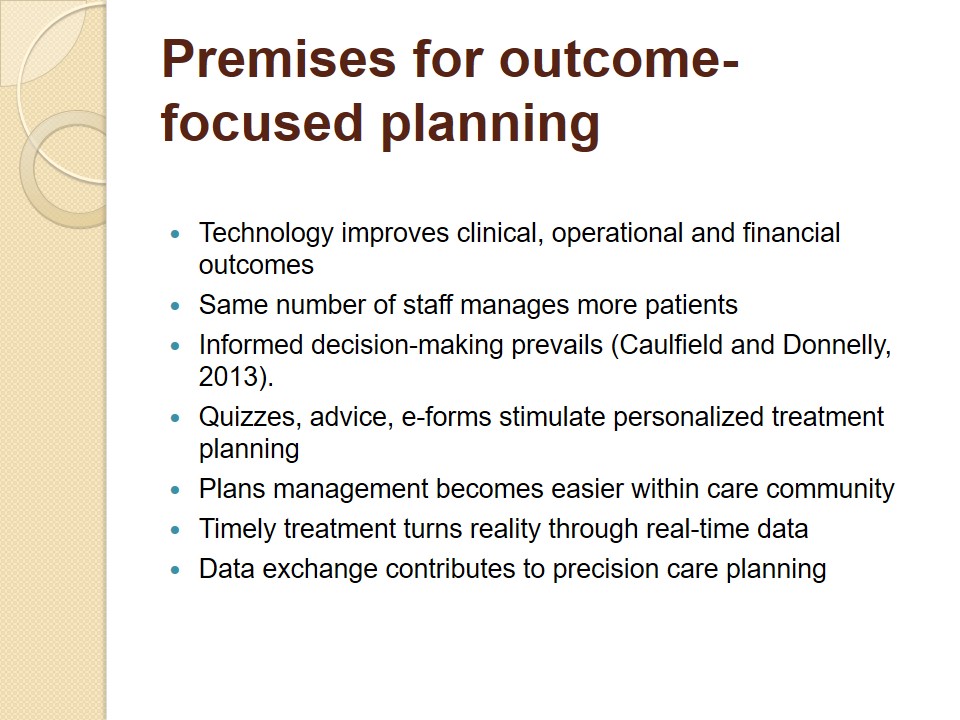
Technology impact on future healthcare delivery
- Data will be transformed real-time across hospitals.
- No need to visit doctors for prescriptions.
- Fast clinic consultation regardless of patient’s location.
- Complex diagnostics considering all data in total.
- Fast diagnosis establishment and outcome-focused treatment planning.
- Real-time heart rate, temperature, and pressure measurements.
- Conferencing with clinicians from around the world.
By analyzing information, retrieved from NantHealth’s medical practice, one may suggest that further integration of Connected Health models will lead to global changes in medicine. In a couple of years, people will no longer need to attend different facilities to receive a complex diagnostics of the major processes. Receiving prescriptions for curing fast-flowing illnesses will be available from home through the use of technological means of data transferring.
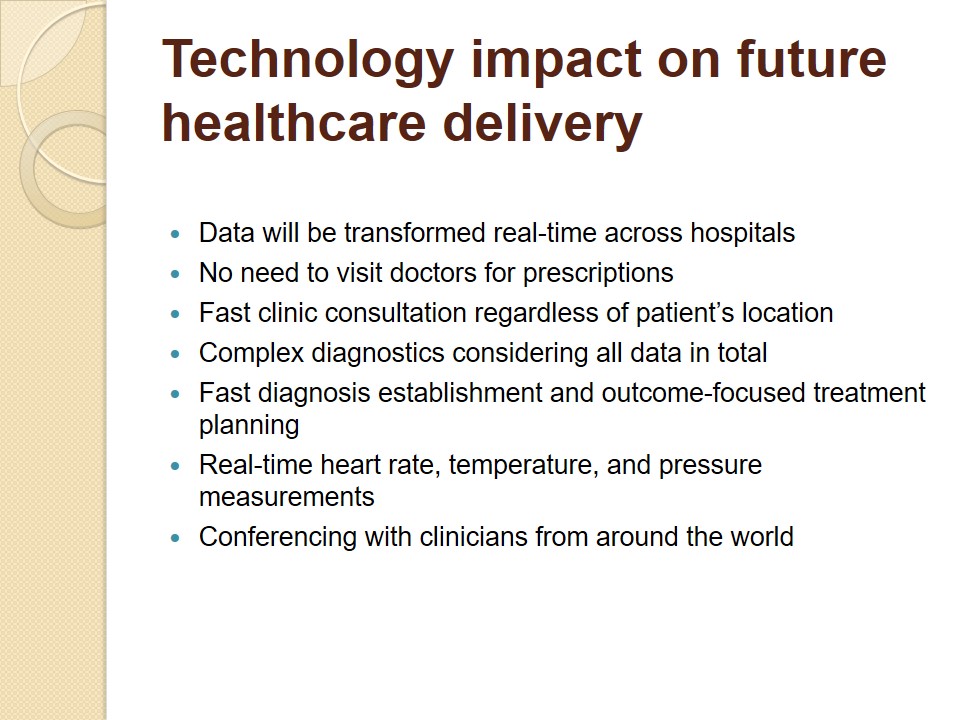
Examples of technology impact on modern medicine
- Health-related apps are developed for commercial use.
- Promoters use technology to disseminate healthcare information.
- Wireless connection gives people access to self-tracking.
- Blood chemistry readings are derived from sensors.
- Digital gaming in healthcare programs (Lupton, 2014).
- ‘Healthy city’ and ‘smart city’ programs implementation.
- Social media platforms for sharing health-related information.
Thousands of health-related apps are available today for commercial use to improve various aspects of patients’ care. Lupton (2014) states that health promoters even referred to using digital gaming to enhance their medical programs. Things like temperature, breathing rate, and blood chemistry sensors are not a fiction any longer. The occurrence of such programs as ‘health city’ and ‘smart city’ serves as the evidence of this fact.

Summarizing the facts
- System-based medicine delivery approach gives impressive results.
- Technology forms backgrounds for precision medicine implementation.
- Software systems contribute to significant cost reduction.
- Clinicians receive enough data for informed decision-making.
- Organized data access leads to accurate diagnostics.
- Close collaboration allows for outcome-focused planning.
- Wireless connection grants a real-time data viewing.
By the example of the NantHealth’s practice, one sees that technology-based approach to treatment delivery does give positive results and is considered to receive further practice implementation. With the help of cloud technologies, clinicians can exchange data and give their feedback in real-time situations. The fact that their healthcare software seriously contributes to the cost reduction makes its usage financially-viable for promoters, which, in its turn, benefits the overall treatment planning and decision-making.
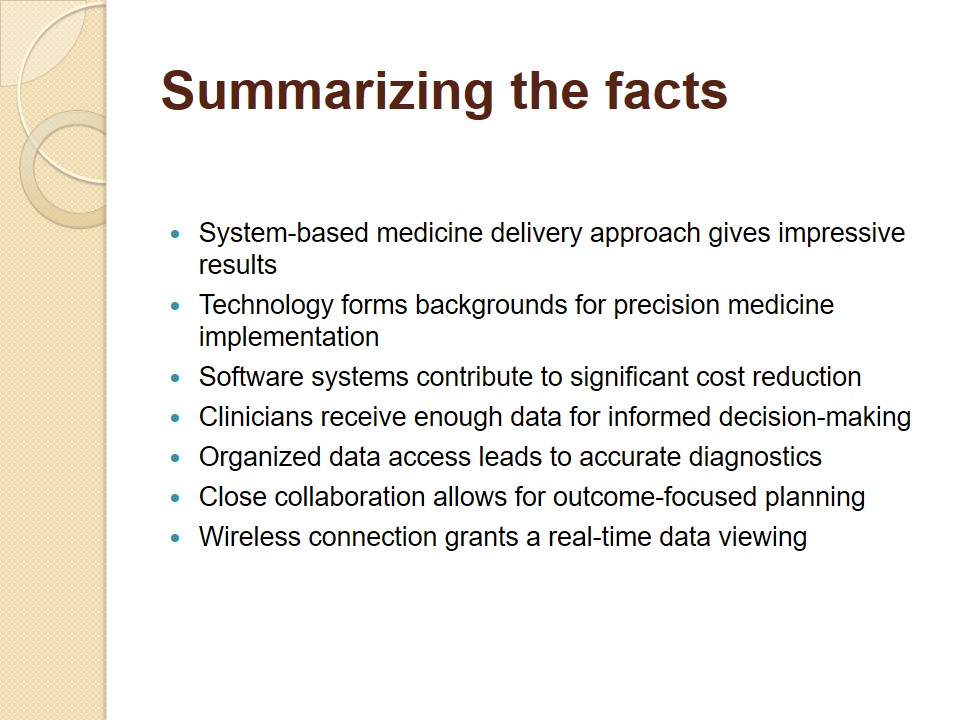
References
Caulfield, B. M., & Donnelly, S. C. (2013). What is Connected Health and why will it change your practice? QJM: An International Journal of Medicine,106(8), 703-707.
Lupton, D. (2014). Health promotion in the digital era: A critical commentary. Health Promotion International, 30(1), 174-183.
Topol, E. (2013). The creative destruction of medicine: How the digital revolution will create better health care. New York, NY: Basic Books.